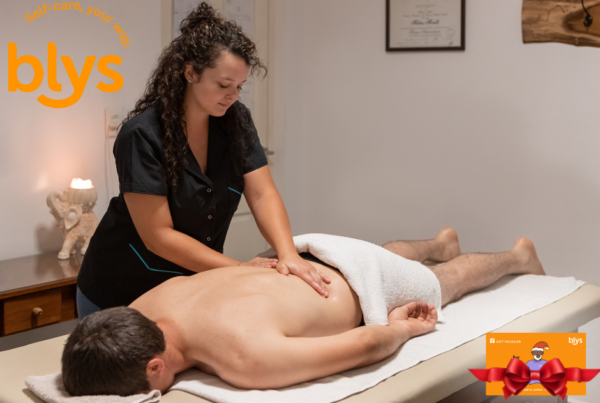
If you’ve ever felt a sharp ache between your shoulder blades or a dull, nagging pain in your lower back that just won’t go away, there’s a good chance you’re dealing with a trigger point. These are small, tight areas within a muscle that can cause discomfort in that exact spot or even refer pain to another part of your body.
They often feel like knots and are more than just a nuisance—they can have a real impact on your daily comfort. Trigger points can form from repetitive strain, poor posture, overuse, or stress. While they may start as mild tension, they can build over time and affect how you move, sleep, and go about your routine.
Untreated, they may lead to stiffness, reduced mobility, and lingering pain that interferes with everyday life. Understanding how these points work is the first step toward long-lasting relief. And that’s where targeted care like remedial massage plays a key role—it helps release these tight spots, reduce pain, and restore your body’s natural movement.
What Are Trigger Points? A Closer Look at Muscle Knots
Trigger points are small, tight areas within muscle fibres that become hypersensitive when touched. Commonly referred to as “muscle knots,” these spots can cause local pain or even discomfort in entirely different areas of the body a phenomenon known as referred pain.
For example, a trigger point in your shoulder might lead to a dull ache down your arm, while one in the lower back could mimic sciatica.
These points often develop gradually due to repeated strain or long-term muscle tension. A variety of everyday habits and conditions can lead to the formation of trigger points, including:
- Poor posture: such as slouching at a desk or looking down at your phone for long periods
- Repetitive movements or overuse: like lifting, typing, or exercising without enough recovery time
Other contributing factors include:
- Stress and emotional tension: which can cause people to unconsciously clench their muscles especially in the neck, shoulders, and jaw
- Inactivity or a sedentary lifestyle: which reduces circulation and causes muscles to stiffen over time
Even sleeping in awkward positions or sitting still for hours can result in shortened, tight muscles that become prone to knotting.
Trigger points are generally classified into two categories:
- Active trigger points: which cause spontaneous pain and can limit your range of motion or affect posture
- Latent trigger points: which only hurt when pressure is applied but can still cause stiffness and muscular imbalance
Understanding how and why trigger points form is a crucial step in managing chronic pain and preventing it from returning. With the right treatment and care, these persistent knots can be effectively addressed to restore comfort and mobility.
Common Trigger Point Issues You Might Experience
Trigger points often follow predictable patterns in the body, which means many people experience the same types of discomfort without knowing the real source. These issues are especially common among people with desk-based jobs, physically active routines, or demanding responsibilities at home. Understanding how these pain patterns work can help you recognise when a remedial massage might be the right solution.
Tension headaches
One of the most common complaints is tension headaches. These often stem from trigger points in the neck and shoulders particularly the upper trapezius and muscles at the base of the skull. The discomfort usually builds gradually, starting as neck tightness before radiating upward into a headache. For desk workers or those who spend long hours on digital devices, this kind of pain is a frequent issue.
Lower back pain
Is another widespread problem, often linked to tight gluteal muscles or the quadratus lumborum in the lower back. Parents lifting toddlers, tradies on their feet all day, or anyone sitting for long periods can all experience this deep, aching pain. It may feel like a dull weight across your lower back or an annoying stiffness that worsens with inactivity.
Radiating arm pain
Can be caused by trigger points in the shoulder region, particularly the infraspinatus or deltoid. This kind of pain may shoot down the arm or feel like a strange heaviness, often confused with nerve issues. People who sleep on one side, carry children or bags on one arm, or train upper body muscles may notice these symptoms more often.
Desk job stiffness
Is commonly tied to trigger points in the trapezius and rhomboids. This tension builds between the shoulder blades and at the base of the neck due to poor ergonomics or extended time spent in a seated position. Even with a proper chair, if posture and breaks aren’t prioritised, muscles begin to tighten and fatigue.
Sports injuries and postural habits
Also contribute to trigger point pain. Runners, gym-goers, and even weekend warriors can develop knots in the calves, hips, or upper back from repetitive strain or imbalance. If any of these scenarios sound familiar, you’re not alone and targeted massage may be exactly what your body needs.
For post-exercise soreness or fatigue, remedial massage can also support recovery—read more in our guide on remedial massage for post-workout recovery.
How Remedial Massage Targets Trigger Points
Trigger points are stubborn knots that can cause pain, restrict movement, and reduce your overall quality of life. While stretching and rest might provide temporary relief, remedial massage offers a more focused, hands-on approach to releasing these tight muscle fibres. Through a combination of techniques, a qualified massage therapist can locate the source of tension, apply targeted pressure, and help your body reset for better function and comfort.
What Is Trigger Point Therapy?
Trigger point therapy is a manual technique designed to identify and deactivate tight, painful spots within a muscle. These points often feel like small nodules or “bands” and are usually tender to the touch. In this method, a massage therapist applies firm, sustained pressure directly to the trigger point until the tissue begins to soften and release.
The goal is to break the cycle of pain and tightness by improving circulation, calming the nervous system, and allowing the muscle to return to its resting state. You might feel some discomfort during the pressure, but it’s usually followed by a noticeable sense of relief and improved movement in the affected area.
Some therapists may also include passive stretching or dry needling in trigger point treatment. However, Blys therapists focus solely on non-invasive, massage-based methods, ensuring a safe and gentle approach suited for all clients even those new to remedial massage.
Other Remedial Massage Techniques That Help
Blys therapists often combine trigger point therapy with a range of complementary techniques to treat the surrounding muscles and fascia, support recovery, and reduce the risk of recurrence.
- Deep tissue massage: works on deeper layers of muscle to release chronic tension and improve circulation. It’s ideal for areas that feel locked up or fatigued from overuse.
- Myofascial release: targets the fascia the connective tissue around your muscles—to reduce restriction and help the body move more freely. This gentle, sustained technique supports long-term flexibility and structural balance.
- Cross-fibre friction: involves applying pressure perpendicular to the muscle fibres, breaking down adhesions and improving blood flow in injured or stiff areas.
- Stretching and movement education: are often incorporated to support ongoing results. Your therapist may guide you through safe, targeted stretches or suggest ways to improve posture and movement habits between sessions.
Together, these techniques form a powerful treatment approach that does more than relieve pain they help reset your body and prevent future issues.
Ready to feel better? Discover trusted mobile therapists offering personalised remedial massage right near you.
What to Expect in a Blys Remedial Massage Session
With Blys, getting a remedial massage doesn’t mean driving across town or sitting in a waiting room. The entire experience is delivered to your door designed to be professional, personalised, and completely stress-free.
Whether you’re a time-poor professional, a parent juggling multiple responsibilities, or simply someone seeking relief from muscle tension, the process is built around your comfort and goals.
Here’s how a typical in-home remedial massage session with Blys works:
| Step | What to Expect |
| 1. Therapist Arrival | Your therapist brings a massage table, clean towels, oils, and all equipment. You just need a quiet space at home. |
| 2. Quick Consultation | A brief chat about your pain points, health history, and goals to personalise the session. |
| 3. Tailored Treatment | The therapist uses techniques like trigger point therapy or deep tissue massage, with pressure adjusted to your comfort. |
| 4. Aftercare Advice | You’ll get practical tips such as stretches, posture support, and hydration reminders to help recovery. |
| 5. Professional Service | All Blys therapists are qualified, insured, and vetted—so you can relax knowing you’re in expert hands. |
This mobile massage model is perfect for those who value convenience without compromising quality. You won’t need to rearrange your day or deal with post-massage travel. Instead, you can simply relax, recover, and enjoy your treatment in your own familiar environment.
Benefits of Targeted Trigger Point Massage
Trigger points don’t just cause isolated pain they can affect how you move, how you sleep, and how your body feels overall. A targeted remedial massage focused on releasing these knots can make a significant difference, especially when guided by a qualified therapist who understands muscular pain patterns.
Here are some of the key benefits you can expect from trigger point-focused remedial massage:
Reduces both local and referred pain
By applying pressure directly to trigger points, massage helps desensitise these areas and interrupt pain signals. This not only eases discomfort at the source but also reduces referred pain that shows up elsewhere in the body like headaches, arm pain, or sciatica-type symptoms.
Increases range of motion and flexibility
Trigger points can limit how far your muscles can stretch or contract. Releasing them improves joint mobility, making it easier to move without stiffness or restriction. This is especially beneficial for people dealing with tight hips, shoulders, or neck.
Improves blood flow and nutrient delivery
Massage increases circulation to the affected areas, which helps oxygenate the tissues, flush out metabolic waste, and speed up the healing process. Better blood flow also supports long-term muscle health.
Supports injury recovery and posture correction
Chronic trigger points often form around injury sites or due to poor posture. Releasing these points can reduce compensatory patterns and muscular imbalances, helping the body return to proper alignment.
Helps prevent recurring tightness
Regular treatment can stop trigger points from reforming by keeping muscles lengthened and healthy. It also helps you become more aware of your body’s tension patterns, making prevention easier with lifestyle adjustments and ongoing care.
One review supports these outcomes, highlighting the effectiveness of manual therapy for treating myofascial trigger points and reducing associated pain and dysfunction
(source).
Trigger point massage isn’t just about short-term relief it’s a practical step toward long-term comfort, mobility, and wellbeing.
Not sure if you need remedial or sports massage? Learn the key differences in our comparison of sports massage vs remedial massage.
When to Seek Professional Help
While occasional muscle tension is common and can often be managed with self-care like stretching, rest, or gentle movement, some symptoms shouldn’t be ignored. Trigger points that go untreated can worsen over time and begin to interfere with your daily life, work, or sleep.
If you’re experiencing any of the following, it may be time to book a professional remedial massage:
- Persistent pain that doesn’t improve: If discomfort continues despite rest, stretching, or using a foam roller, the issue may be rooted in deep muscular tension that needs hands-on treatment.
- Frequent or recurring tension headaches: Trigger points in the neck and shoulders are a common cause of headaches. If they keep returning or are affecting your concentration, a targeted massage could help address the underlying cause.
- Limited range of motion or stiffness: If you’re struggling to turn your head, lift your arms, or bend comfortably, tight muscles may be holding your joints back. Remedial massage can help release those restrictions and restore mobility.
- Pain that radiates or disrupts daily activities: Referred pain from trigger points can spread down the arms, legs, or into the back making everyday movements difficult or painful. This is a sign the issue may be deeper than it seems.
If you’re unsure whether your symptoms are muscular or related to another condition, it’s always best to consult your GP first. A medical check-up can help rule out other causes and guide you toward the appropriate treatment.
When you’re ready for relief, a qualified Blys therapist can deliver expert care right to your home personalised to your needs and lifestyle.
Understanding Your Body With Blys
Trigger points may be small, but their impact on your daily comfort can be significant. Understanding where they come from and how they affect your movement and wellbeing is the first step toward managing them effectively.
The good news is that trigger point-related pain is highly treatable. With the right combination of targeted massage and supportive self-care, you can ease discomfort, restore mobility, and prevent future flare-ups.
If you’ve been dealing with persistent tension, stiffness, or unexplained aches, it might be time to listen to what your body’s been trying to tell you. A mobile remedial massage session can be fully tailored to your needs right in the comfort of your own home.
Feel better, move easier. Book your in-home remedial massage with Blys and let your body reset right away.





